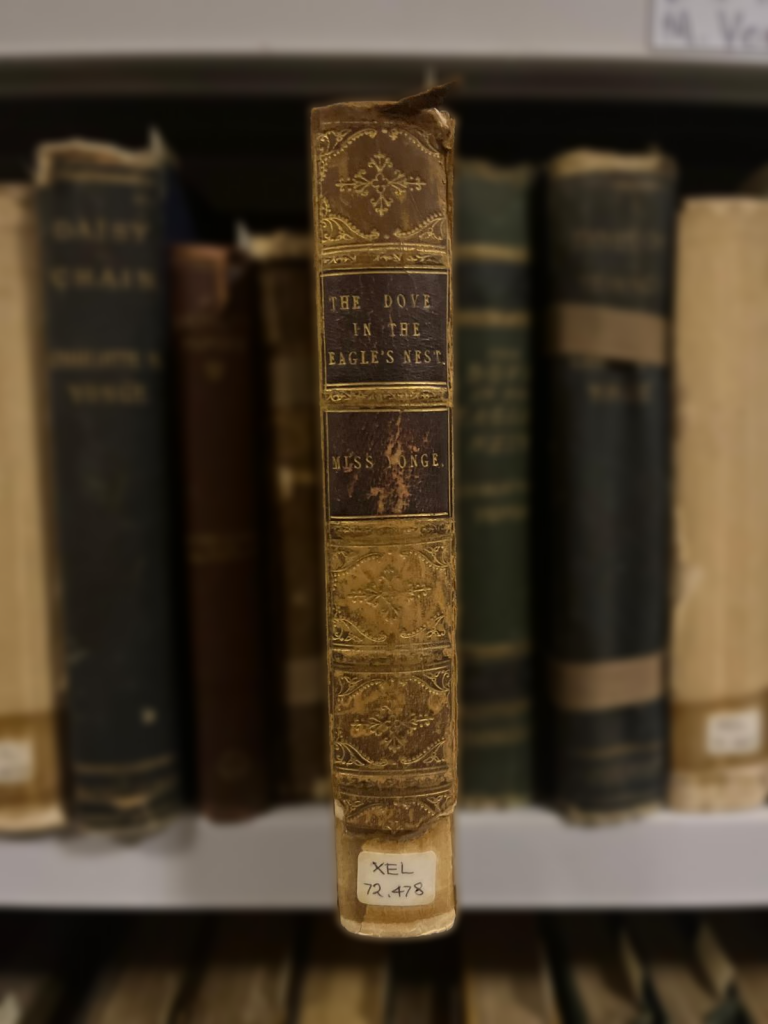Special Collections
Forgotten Bestsellers: The Charlotte Mary Yonge Collection
Charlotte Mary Yonge (11 August 1823 – 24 March 1901) was a devout Anglican, long-serving Sunday School teacher, and the enthusiastic author of over 160 books and articles throughout the 19th century.
A notorious home bird, Yonge rarely strayed far from the town in which she was born, Otterbone in Hampshire. Here she was educated by a strict father and later mentored by John and Charlotte Keble, who were family friends and neighbours. The Yonge family were well-connected members of the High Church and instilled a deep morality and strong Christian values in Charlotte, which played a significant role in the writing of the budding authoress. Dubbed ‘the novelist of the Oxford Movement’[i], Yonge displayed a talent throughout her career for blending entertaining narratives with moral instruction, which appealed to her Victorian readership. Yonge regarded her purpose as an author to promote Tractarian ideology to groups that may not be easily reached by the male-dominated and intellectual founders of the movement[ii], thus her writing centred on everyday domesticity and appealed to a broad audience, particularly one of young women and families.

Charlotte Mary Yonge, circa 1845
Having published as early as 1839 with little success outside the High Church, Charlotte Yonge became a widely-known household name after the publication of her breakthrough novel The Heir of Redclyffe in 1853 by J.W. Parker & Son. Yonge was encouraged to write by a neighbour, Marianne Dyson (1809-1878), who is later referred to in Yonge’s letters as ‘Guy’s Mother’ for the input she had in developing the characters in the novel. The Heir soon gained global notoriety, with seventeen editions published in the first fifteen years, and even Louisa May Alcott’s Massachusettsan protagonist Jo March “eating apples and crying over [the book].”

Frontispiece to The Heir of Redclyffe, 1883
John and Charlotte Keble continued to mentor Yonge in her sudden popularity, providing opinions and edits to her writing, as well as spiritual guidance. In a moment of concern about her own ‘vainglory’ John Keble remarked how “a successful book might be the trial of one’s life”[iii] and advised her that she should make it clear that her true inspiration and dedication is to God.
Legacy
Charlotte Mary Yonge continued to write prolifically until her death in 1901, crossing between fiction and non-fiction, and a range of genres, including historical novels, children’s literature, religious works and biographies. Free from relying on writing for income, Yonge chose to donate a significant portion of her earnings to charitable and missionary work.

Victorian cloth bindings
Virginia Woolf would read Yonge’s novels to her sister, counting the death total as they went, and supposedly even took a copy of The Heir of Redclyffe on her honeymoon. Barbara Pym, an English novelist who was nominated the most underrated writer of the century by Philip Larkin, shows a clear fondness for the novels of Yonge, referencing them multiple times in her own work. Lewis Carroll, George Eliot and Christina Rosetti are some notable names for whom Charlotte Mary Yonge’s books took up library real estate, with William Morris and Edward Burne-Jones reportedly reading her work aloud to each other while students at Oxford.
So, if Charlotte Mary Yonge was so influential, why isn’t she better known today? The simplest theory is that her work fell out of favour as Victorian feminism and religious trends evolved. Her writing, which was so rooted in faith, came to be seen as overly conservative, and her strong leaning towards tradition rather than progress, made it difficult for her work to find a place in the emerging feminist landscape.
Keble College Collection
It is unsurprising that a college birthed from the Oxford Movement should have a good collection of novels by Charlotte Mary Yonge, and in fact, a significant portion of the collection was donated by the authoress herself on the foundation of the college in 1870-1871. Later contributions include a donation by Judith and Benedict Sefi in October 1989 and Lady Margaret Hall Library.

Bookplate of Keble College Library, with inscription
131 volumes make up the collection at Keble: 86 novels in 96 volumes, 6 collections of short stories, and 20 works of non-fiction in 29 volumes. The collection spans a century exactly, with the earliest work having been published in 1848, and the latest 1948. While some of these works had previously been shelved in Keble College’s Upper Library, they were later moved to live with the special collection of early printed books, in a temperature and humidity controlled strong room.

Victorian leather spine of Dove in the Eagle’s Nest, 1876
Shelved in title order, the collection remained uncatalogued and therefore not easily searchable, though incomplete handlists do exist in paper form. With Yonge’s bicentenary celebrations taking place in 2023, a retrospective cataloguing project was put in motion in October 2023. The aim of the project has been to create bibliographic records which could be accessed through the University of Oxford’s union catalogue SOLO, making the collection searchable.
[i] Charlotte Yonge: novelist of the Oxford movement by Barbara Dennis. Edwin Mellen Press, 1992.
[ii] Charlotte Mary Yonge: writing the Victorian age edited by Clare Walker Gore, Clemence Schultze and Julia Courtney. Palgrave Macmillan, 2022.
[iii] Charlotte Mary Yonge: An Appreciation by Ethel Romanes. Mowbray, 1908.
Written by Leona Stewart, November 2025
